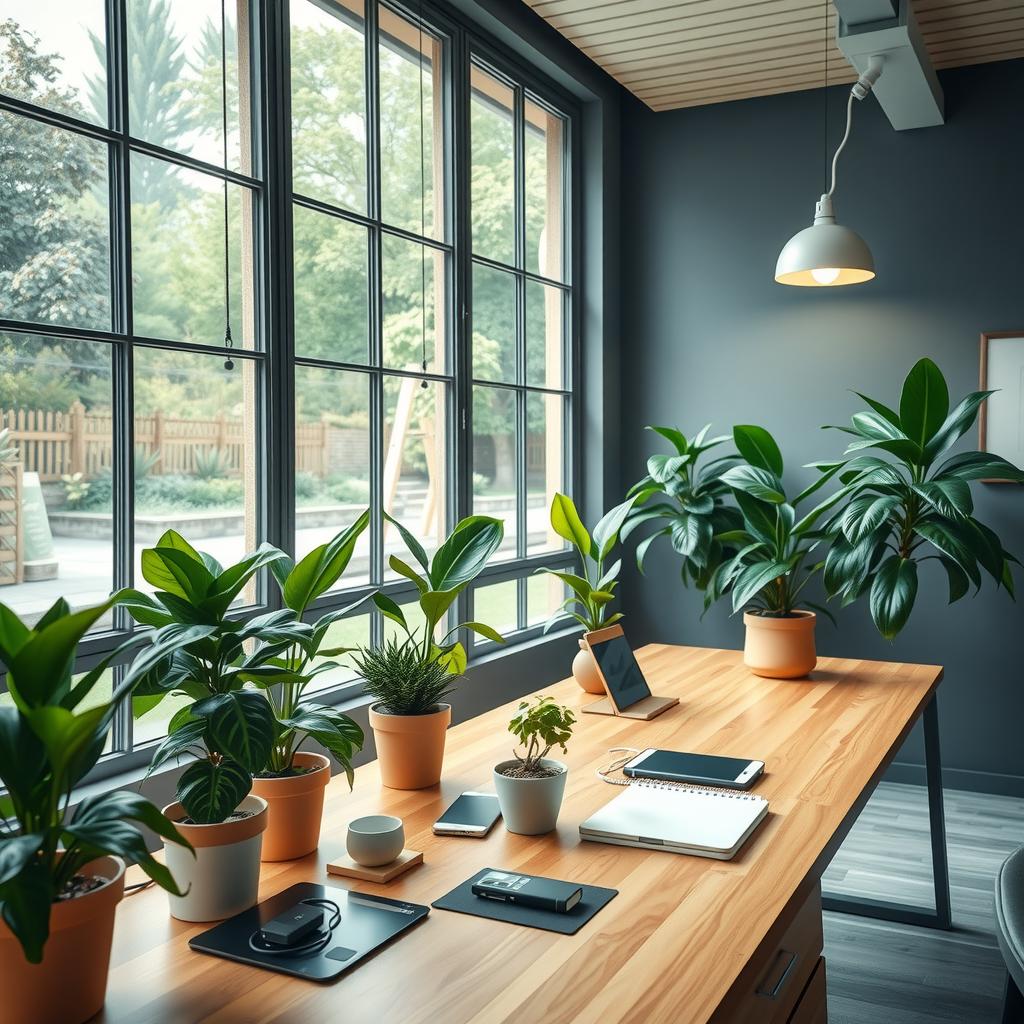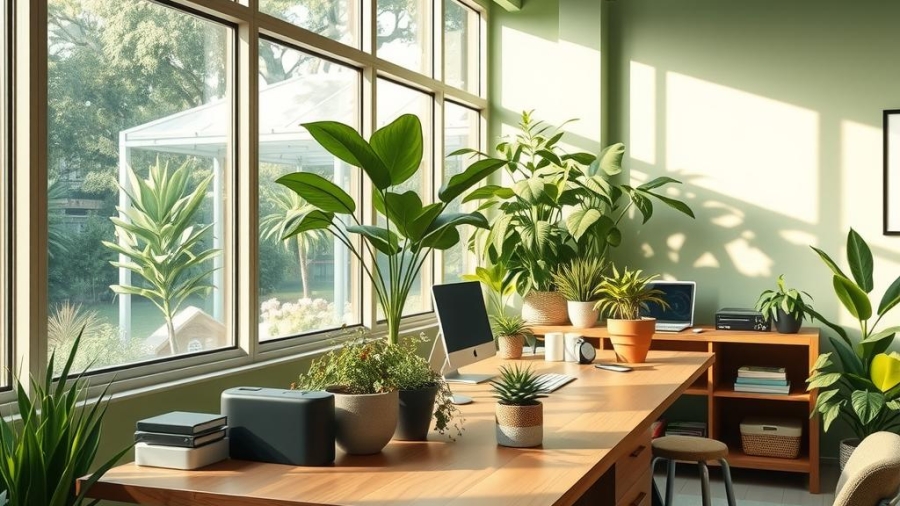As the trend of remote work continues to reshape the modern workplace, many individuals are now tasked with creating a functional and sustainable home workspace. This shift presents an opportunity for remote workers to embrace eco-friendly practices that not only enhance productivity but also contribute positively to the environment. The blog post titled Energy-Saving Tips for Remote Workers serves as a comprehensive guide for those looking to optimize their setup while minimizing their carbon footprint. By implementing remote work energy-saving tips, professionals can transition from traditional office environments into efficient ecosystems that prioritize sustainability without sacrificing comfort or effectiveness.
Creating an energy-efficient home office begins with intentional choices in equipment and design. Selecting energy-efficient appliances, such as LED lighting and smart power strips, is crucial for establishing a green working environment. These products not only reduce overall electricity usage but also promote better power management for devices, ensuring that they consume less energy during downtime. Moreover, investing in efficient office equipment choices—like Energy Star-rated computers and printers—can significantly lower energy consumption at home while supporting optimal performance.
Furthermore, the layout of a workspace can impact both productivity and energy conservation efforts. Natural light plays an essential role; therefore, positioning desks near windows allows employees to utilize daylight instead of relying solely on artificial lighting during daytime hours. Incorporating plants into the decor can improve air quality while enhancing aesthetic appeal—a testament to how aesthetics and efficiency can coexist within a sustainable home workspace.
In addition to structural changes, remote workers should consider behavioral adjustments that align with sustainable practices. Implementing simple habits like turning off devices when not in use or utilizing sleep mode settings helps in reducing unnecessary power drain throughout the day. Adopting these strategies contributes significantly towards achieving long-term goals associated with decreasing one’s environmental impact.
Ultimately, by following these Energy-Saving Tips for Remote Workers outlined within this article, individuals can cultivate an eco-friendly office setup tailored specifically to meet their needs while championing sustainability principles in everyday operations. Embracing this mindset fosters not just personal responsibility but collective action toward greener living standards across communities engaged in remote work environments.

Key points:
-
Title of the key point: Establishing an Energy-Efficient Home Office
An energy-efficient home office begins with thoughtful planning and design. By carefully selecting a workspace within the home that maximizes natural light and minimizes heat loss, one can create a comfortable environment while reducing reliance on artificial lighting and heating. Incorporating elements like double-glazed windows, proper insulation, and strategically placed plants not only enhances aesthetics but also contributes to significant energy-saving tips for remote workers by fostering a sustainable home workspace. -
Title of the key point: Selecting Efficient Office Equipment Choices
When setting up an eco-friendly office setup, it is crucial to invest in energy-efficient equipment. This includes choosing computers, printers, and other devices that are ENERGY STAR certified or have similar efficiency ratings. These choices significantly contribute to lowering electricity costs while maintaining high productivity levels. Furthermore, opting for multi-functional devices can help streamline operations in a green working environment, ultimately supporting remote work energy-saving tips. -
Title of the key point: Implementing Power Management for Devices
Effective power management settings play an essential role in reducing energy consumption at home. By utilizing sleep modes and hibernation features on computers and peripherals when they are not in use, individuals can drastically cut down their overall electricity usage without sacrificing functionality. Regularly updating software related to device management ensures optimal performance aligned with energy-saving tips for remote workers, promoting both productivity and energy conservation. -
Title of the key point: Balancing Productivity with Energy Conservation
Finding harmony between productivity demands and efforts toward sustainability is vital in any modern workplace—especially within a sustainable home workspace. Developing habits such as scheduled breaks away from screens allows employees to recharge mentally while minimizing unnecessary power draw from electronic devices during idle times. This approach aligns seamlessly with effective remote work energy-saving tips, ensuring that professionals maintain focus without detracting from their commitment to reduce overall resource consumption. -
Title of the key point: Creating an Eco-Friendly Office Setup
A well-thought-out eco-friendly office setup goes beyond just equipment; it encompasses all aspects of one’s work environment including furniture choices made from sustainable materials or using recycled products wherever possible. Such decisions enhance aesthetic appeal while contributing positively towards creating an efficient workspace aimed at preserving environmental resources—a central goal outlined in various energy-saving tips for remote workers. Emphasizing practices that promote recycling paper products or utilizing digital formats further solidifies this commitment toward building greener habits within daily routines.

Designing the Layout for Comfort and Efficiency
Creating a Productive Workspace that Aligns with Sustainability Goals
The layout of an energy-efficient home office plays a crucial role in fostering productivity while adhering to sustainable principles. To create a workspace that prioritizes comfort, it is essential to carefully consider the arrangement of furniture and equipment. Ergonomic desks and chairs should be positioned to promote good posture and reduce strain during long working hours. Furthermore, keeping essential items within arm’s reach minimizes unnecessary movement, enhancing both efficiency and productivity. The strategic placement of devices can also aid in power management for devices, helping to optimize electrical usage throughout the workday. Incorporating plants or natural elements into the design not only enhances aesthetics but also contributes positively to indoor air quality, creating a green working environment that supports overall well-being.
In addition to physical layout considerations, incorporating technology designed for energy conservation is vital for any sustainable home workspace. Utilizing energy-efficient lighting options such as LED bulbs can significantly reduce electricity consumption compared to traditional incandescent lights. Natural light should be maximized wherever possible; positioning desks near windows allows sunlight to illuminate the workspace during daylight hours while reducing reliance on artificial lighting—an important principle outlined in Energy-Saving Tips for Remote Workers. By utilizing window treatments judiciously, individuals can control glare while allowing ample light flow into their spaces without compromising privacy or comfort.
Harnessing Natural Lighting
Maximizing Sunlight Exposure While Reducing Energy Costs
Natural lighting serves as one of the most effective ways to enhance an eco-friendly office setup while simultaneously improving mood and focus among remote workers. A well-lit space fosters creativity and increases alertness; therefore, it is critical that designs allow sufficient sunlight penetration without overheating or causing discomfort throughout different seasons of use. Implementing large windows or skylights promotes this objective effectively but must be balanced against insulation techniques that prevent drafts during colder months.
To optimize natural light exposure further, implementing reflective surfaces—such as mirrors—can help distribute sunlight more evenly across darker corners of the office space, thus maximizing illumination without additional energy costs associated with electric lights. Such decisions align seamlessly with efficient office equipment choices by ensuring fewer electronic devices are left powered on unnecessarily due solely to poor visibility conditions caused by inadequate lighting sources.
Additionally, integrating smart technologies often found in remote work energy-saving tips can automate shading solutions based upon weather patterns; these adjustments minimize heat gain from direct sun exposure when temperatures rise outside yet maximize warmth when needed indoors during cooler periods—a dual benefit supporting both comfort levels within living quarters along with responsible resource management practices aimed at reducing overall energy consumption at home. This careful integration demonstrates how thoughtful planning around natural resources ultimately leads toward achieving sustainability goals efficiently within one’s daily habits despite being confined primarily largely indoors amidst modern life challenges today.

Choosing Energy-Efficient Office Equipment
Sustainable Solutions for the Modern Workplace
In an era where sustainability and efficiency are paramount, selecting the right office equipment becomes crucial for both productivity and environmental impact. Companies and remote workers alike must consider how their choices affect energy consumption, particularly in a sustainable home workspace. Energy-efficient devices not only reduce electricity bills but also contribute to a greener working environment by minimizing carbon footprints. For instance, when choosing computers, opting for models that feature low power modes or energy-saving processors can significantly lower overall energy use without sacrificing performance. This is particularly relevant in contexts like telecommuting where individuals often rely heavily on their machines throughout the day.
Printers stand out as another critical area where energy savings can be realized. Many modern printers offer duplex printing capabilities which save paper and thus reduce the frequency of replacements—translating into less waste overall. Furthermore, many eco-friendly options are designed with sleep modes that activate during periods of inactivity, further conserving power while maintaining readiness for quick tasks. Integrating these features into an eco-friendly office setup ensures that users do not have to compromise between functionality and sustainability.
Remote work presents unique challenges regarding reducing energy consumption at home. The implementation of effective power management strategies is essential; utilizing smart plugs or timers can automate shutoff times based on user schedules, thereby preventing unnecessary standby power usage from devices left plugged in after hours. Additionally, investing in high-efficiency monitors with LED backlighting improves visual clarity while simultaneously reducing electricity draw compared to older LCD technologies.
When evaluating efficient office equipment choices, it’s vital to consider certifications such as ENERGY STAR ratings which indicate superior environmental performance across various device categories including computers and printers. These standards guide consumers toward products that align with their goals of achieving greater productivity alongside energy conservation. Moreover, leveraging tools such as Energy-Saving Tips for Remote Workers can provide practical advice tailored specifically towards optimizing one’s home office environment further reinforcing commitment to sustainable practices without compromising output quality.
Lastly, integrating these elements into everyday operations fosters a culture focused on both productivity and environmental stewardship among teams regardless of location—a principle increasingly valued by today’s workforce striving towards a balanced approach amid rising ecological concerns. By making informed decisions about equipment purchases and operational habits within their offices or homes using comprehensive resources like remote work energy-saving tips, individuals empower themselves not only through enhanced efficiency but also play a part in nurturing our planet’s future health.

Power Management Strategies for Enhanced Efficiency
Unlocking the Potential of Smart Technology
Efficient power management settings in computers and devices play a crucial role in creating an energy-efficient home office environment, particularly for remote workers. By configuring these settings carefully, individuals can significantly lower energy consumption while still maintaining high levels of productivity. For instance, activating sleep mode on devices when not in use is a simple yet effective way to minimize energy waste. According to research, implementing such measures can lead to substantial savings over time, making it essential for anyone interested in sustainable practices at home. The product Energy-Saving Tips for Remote Workers offers valuable insights into optimizing device settings that align with eco-friendly office setup principles.
Incorporating remote work energy-saving tips into daily routines enhances both sustainability and performance within the workspace. Effective strategies include adjusting screen brightness and utilizing power-saving modes available on most operating systems. Moreover, considering efficient office equipment choices—such as LED monitors or ENERGY STAR-rated peripherals—can result in significant reductions in overall electricity usage without compromising functionality or comfort during work hours. Adopting these practices contributes not only to personal productivity but also fosters a more responsible approach towards creating a green working environment.
Configuring Devices for Optimal Performance
Enhancing Productivity through Smart Settings
The interplay between productivity and energy conservation is pivotal when establishing a sustainable home workspace. Tools like the Energy-Saving Tips for Remote Workers guide users toward understanding how software updates can improve system efficiency while simultaneously reducing power consumption. Regularly updated programs often come with better optimization features that help enhance device performance without excessive energy drawdown—a vital aspect of modern remote work dynamics. Additionally, setting printers and copiers to automatic duplex printing helps cut paper usage alongside electric output.
Furthermore, adopting practices such as managing device charging times plays an essential role in minimizing excess electricity use at home; this involves unplugging devices once fully charged or using smart plugs equipped with timers that shut off power after certain intervals. These mindful actions contribute collectively towards reducing energy consumption at home while ensuring seamless workflow processes remain intact throughout the day’s tasks—a balancing act expertly detailed by resources like Energy-Saving Tips for Remote Workers.
Creating Sustainable Work Environments
Implementing Green Practices Effectively
Transforming one’s workspace into an efficient hub requires deliberate choices about technology utilization within any given setting—the foundation upon which effective power management for devices rests lies heavily on informed decision-making regarding equipment selection and operational protocols established by users themselves.
Organizations are increasingly recognizing their responsibility toward environmental stewardship through initiatives aimed at enhancing workplace sustainability; thus equipping employees with tools to establish their own eco-conscious environments becomes imperative.
With guidance from products like Energy-Saving Tips for Remote Workers, professionals are encouraged not only to invest wisely but also be proactive participants who actively engage with aspects pertaining specifically to improving their environmental footprint while reaping tangible benefits associated directly linked back towards enhanced efficiency across all operations undertaken daily—ultimately leading toward reduced overhead costs paired alongside unwavering commitment shared amongst teams aiming squarely focused solutions!

Frequently Asked Questions:
Q: What are some essential strategies for setting up an energy-efficient home office?
A: To create an energy-efficient home office, individuals should focus on selecting sustainable materials and utilizing natural light as much as possible. Incorporating elements such as energy-saving lighting, insulated windows, and eco-friendly furniture can significantly reduce energy consumption. The guide Energy-Saving Tips for Remote Workers provides additional insights into designing a workspace that promotes both comfort and environmental responsibility.
Q: How can one choose and use energy-efficient office equipment effectively?
A: When selecting office equipment, it is crucial to prioritize models that have high Energy Star ratings or other certifications indicating lower energy usage. Energy-saving features like automatic shut-off when not in use should also be considered. By following the recommendations in Energy-Saving Tips for Remote Workers, remote workers can make informed choices about efficient office equipment while ensuring their setup remains functional.
Q: What power management settings should be implemented for computers and devices?
A: Effective power management for devices includes adjusting settings such as sleep mode, screen brightness reduction, and scheduling downtime during non-working hours. Utilizing these features not only conserves electricity but also prolongs the lifespan of devices. For comprehensive guidance on optimizing device performance without sacrificing productivity, refer to Energy-Saving Tips for Remote Workers.
Q: How can individuals balance productivity with energy conservation in their workspaces?
A: Balancing productivity and energy conservation involves creating a structured routine where tasks are completed efficiently while minimizing unnecessary power usage. This might include using task lighting instead of overhead lights or keeping electronic clutter to a minimum to facilitate better airflow around equipment. The tips outlined in Energy-Saving Tips for Remote Workers assist users in achieving this delicate balance within their green working environment.
Q: What role does reducing overall energy consumption play in maintaining a sustainable home workspace?
A: Reducing energy consumption at home is fundamental to establishing a truly sustainable home workspace. Simple actions like unplugging chargers when not needed or using multi-device charging stations help minimize wasteful practices. Resources such as Energy-Saving Tips for Remote Workers provide practical steps that contribute towards fostering an eco-friendly office setup while enhancing overall efficiency.
